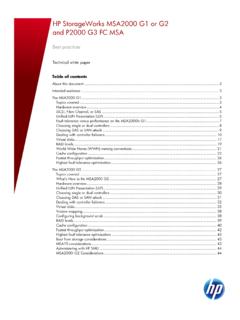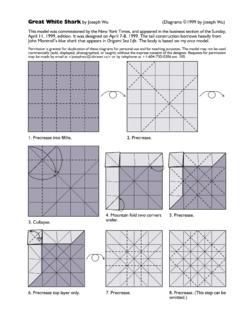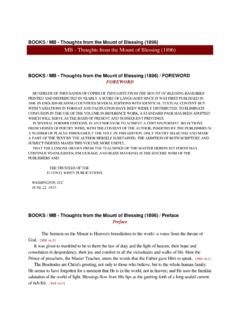Transcription of Distillation Column Flooding Diagnostics with …
1 Distillation Column Flooding Diagnostics with Intelligent Differential Pressure Transmitter Distillation is a common unit operation, which is used to separate or purify components in a feed stream. Flooding is a common abnormal process condition wherein the Distillation Column stops generating a separation, thus causing the quality of the top and/or bottom products to go off specification. The Rosemount 3051S Pressure Transmitter with Advanced Diagnostics can be used to detect incipient Flooding in real time, and provide an early warning. Figure 1 illustrates the results of a field test in which Flooding was deliberately and repeatedly triggered by increasing the heat supplied to the reboiler. The standard deviation, provided by the Rosemount transmitter, increases each time Flooding is triggered; from which, an incipient Flooding alert threshold can be defined.
2 When this threshold is exceeded, it indicates the Distillation Column is still producing a good separation; but, is about to flood. Because this technique detects a physical phenomena intrinsically associated with Flooding , it is believed to be widely applicable. Users of Rosemount DP transmitters with Advanced Diagnostics will be able to confidently push their Distillation columns closer to their operational limits and quickly eliminate Flooding as a root cause of product quality issues. March 6, 2008 - Reboiler Duty SP. PV. Reboiler Duty (MMBTU/hr). 1. 11:45 12:00 12:15 12:30 12:45 13:00 13:15. Diagnostics Standard Deviation Flooding Alert Standard Deviation Threshold (in H2O). 11:45 12:00 12:15 12:30 12:45 13:00 13:15. Time of Day Figure 1 Robust Flooding Alert Introduction Distillation is a process used across many industries, including refining and chemical.
3 In a Distillation system a feed stream containing a mixture of components is separated or purified into two or more product streams enriched in certain feed components and depleted in others. Distillation is probably the most common separation or purification process in use The process of Distillation is very energy intensive and can contribute to more than 50% of plant operating Thus, there is great interest in operating Distillation columns as efficiently and reliably as possible. Figure 2 illustrates the basic components of a Distillation A feed stream, usually liquid, consisting of a mixture of components to be separated, is fed into a vessel. This vessel is usually a tall cylinder in shape, standing vertically and is commonly referred to a Distillation Column . Inside the vessel are structures designed to cause intimate radial mixing ( mixing at any given vertical level); but, not axial mixing ( mixing along the length of the vessel) and contact area between a stream of vapor flowing up and a stream of liquid flowing down.
4 These structures can take the form of discrete trays or stages or they can be in the form of packing. Packing can be either randomly dumped shapes with names like Rashig Rings , Beryl Saddles , etc., or the packing can be a so-called structured packing such as Koch Flexipacktm . The purpose of all these different types of Column internal structures is the same: to facilitate vapor/liquid contacting and mass transfer. The part of the Distillation Column above the feed point is commonly referred to as the Enriching Section or the Rectification Section . The part of the Distillation Column below the feed point is known as the Stripping Section . Liquid trickles down the Column , exits the bottom of the Stripping Section, and flows into the reboiler. The reboiler is a special type of heat exchanger that uses steam or some other heat transfer fluid to heat the liquid in the reboiler to its boiling point.
5 The vapor generated by this boiling liquid exits the reboiler and is fed back into the Stripping Section of the Column . Excess liquid in the reboiler overflows a weir and exits the process as the Bottoms Product , sometimes referred to as the Bottoms . The vapor from the reboiler flows up the Column , countercurrent to the liquid flowing down the Column . The components in the feed stream are separated according to their relative boiling points. Components with a lower boiling point tend to become enriched in the vapor traveling up the Column . Components with a higher boiling point tend to become enriched in the liquid traveling down the Column . Eventually, the vapor enriched in low boiling components exits the Rectification Section on the top of the Distillation Column . This vapor is condensed back to a liquid by cooling in a heat exchanger called the condenser.
6 The condensed liquid is collected in the reflux drum. A portion of the condensed liquid is fed back into the Rectification Section to become the liquid flowing down the Column as described previously. The rest of the liquid exits the process as the Top Product or the Distillate . Figure 2 - Basic Components of Distillation Challenge: Flooding in Distillation Columns A common problem that can occur in Distillation columns is Flooding . Figure 3 illustrates a cross section through a Distillation Column , filled with a structured packing, showing the liquid flow and vapor flow when the Column is operating normally. Liquid is flowing downward over the structured packing countercurrent to the upward flowing vapor. The vapor must follow a tortuous path; but, the void space in the packing is predominantly filled with vapor. The vapor is said to be the continuous phase.
7 The upward flow of the vapor exerts an aerodynamic drag on the falling liquid. This drag force acts in opposition to the force of gravity and slows the flow of the falling liquid. When the relative flow rates of the vapor and liquid are such that the drag force is greater than or equal to the gravity force; then, the liquid stops flowing down the Column . This condition is called Flooding . Flooding can begin at any vertical location in the Column . LIQUID. Packing VAPOR. Figure 3 - Normal Condition: Vapor Flow Is Continuous Phase with Falling Liquid Droplets Figure 4 illustrates the same cross section through the Column as Figure 3 except the Column is Flooding . LIQUID. Packing VAPOR. Figure 4 - Flooded Condition: Vapor Flow Becomes Rising Bubbles in Continuous Liquid Phase Note how the flow regime has changed. The liquid is now the continuous phase with bubbles of vapor rising through it.
8 The rising bubbles tend to drag a lot of liquid upward, thus causing undesirable axial mixing in the Column . The net effect is the Distillation Column stops generating a separation and the top product and the bottom product become similar in composition to the feed stream. The bubbles have a distribution of sizes and tend to nucleate, grow, agglomerate, and break apart randomly. As a result, bubble flow tends to be a random, chaotic process. If the pressure drop were measured across the packing, it is expected this random bubble flow process would contribute a broad spectrum or white noise component to the pressure drop signal. This white noise component is not expected to be present during normal operation. Figure 5 shows the conditions visible through a sight glass in a Distillation Column filled with a structured packing in normal operation.
9 Note the open void space within the packing with liquid weeping out of the packing at several points. Figure 5 Viewport #3 with Column in Normal Operation Now, contrast Figure 5 with the view through the same sight glass when the Column is Flooding in Figure 6. The highly chaotic bubble flow is quite evident. A motion picture of the fluid action in Figure 6 would resemble the view through the viewing port on a front loading clothes washing machine. Figure 6 - Viewport #3 with Column Flooding In actual practice, Distillation columns usually have numerous control loops, running in Auto, controlling process parameters like feed rate, Column pressure, reboiler heat duty, reflux ratio, top and/or bottom product compositions, various temperatures, etc. The action and interaction of these control loops can make detection and diagnosis of Flooding In order to make it easier to study Flooding in Distillation columns; it is common practice to simplify the operation of the system.
10 Figure 7 illustrates how this is accomplished, by eliminating the feed stream into the Column as well as the distillate product and bottom product streams out of the Column . Instead, all of the condensed top product is sent back down the Column as liquid reflux. All of the bottom product is boiled back up the Column as vapor by the reboiler. Distillation columns operating in this mode are said to be on total reflux or 100% reflux mode . In 100% reflux mode, the only process parameter that can be changed is the reboiler heat duty. Flooding is triggered by increasing the reboiler heat duty. Increasing the reboiler heat duty causes more vapor to be boiled up, which increases the vapor flow up the Column . Eventually, the increasing vapor flow rate exceeds a critical threshold and triggers Flooding . Although Figures 3 and 4 may imply that Flooding is simply a discrete, on/off phenomenon, this is not necessarily true.















